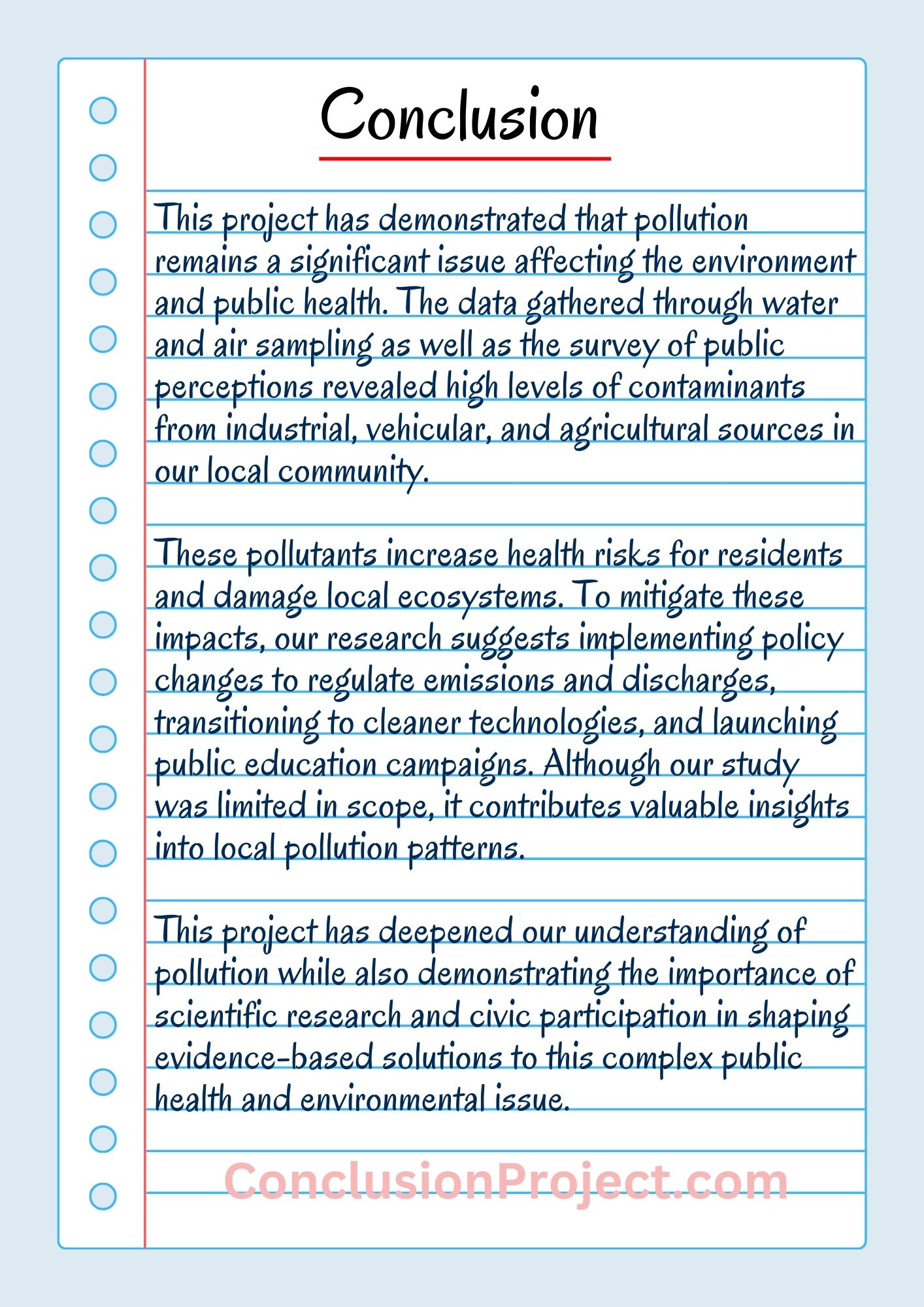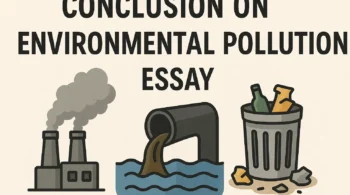The conclusion is a critical part of any pollution study or essay, synthesizing key points into meaningful takeaways. An effective conclusion does more than just summarize the main findings, it reinforces the real-world significance of the work. By tying the results back to the original objectives and research questions, the conclusion shows how the study has addressed or advanced understanding of the pollution problem at hand.
It also suggests practical next steps, whether further research to fill gaps or recommendations for policy and action to mitigate pollution based on the implications of the work. The conclusion provides a sense of closure for the reader, imparting final thoughts to leave a lasting impression regarding what has been learned and why it matters.
How to write conclusion of pollution project?
- Restate the project’s purpose and objectives. Open the conclusion by revisiting the goals and research questions that framed your study.
- Summarize key findings and results. Synthesize major outcomes, statistics, trends, and highlights from your data analysis and discussion into a concise summary.
- Draw clear conclusions. State what the key findings mean and what conclusions can be reasonably drawn from your results.
- Discuss real-world implications. Address the significance of your work and project outcomes for understanding and addressing pollution problems.
- Make recommendations. Suggest evidence-based actions, further research, or changes in practices, policies, technologies, etc. to apply what was learned.
- Acknowledge limitations. Identify any constraints, gaps, or shortcomings in the project methodology, data, and applicability of findings.
- End with a memorable final statement. Provide closure with a statement reinforcing the importance or meaningfulness of the project.
- Proofread and refine. Polish the language, logic flow, and presentation of the conclusion section. Ensure a professional tone.
- Double check against introduction. Verify the conclusion aligns with the original rationale and purpose of the project.
- Cite references if needed. Include in-text citations for any sources referenced in the conclusion section.
Conclusion of Pollution Project
This project has demonstrated that pollution remains a significant issue affecting the environment and public health. The data gathered through water and air sampling as well as the survey of public perceptions revealed high levels of contaminants from industrial, vehicular, and agricultural sources in our local community.
These pollutants increase health risks for residents and damage local ecosystems. To mitigate these impacts, our research suggests implementing policy changes to regulate emissions and discharges, transitioning to cleaner technologies, and launching public education campaigns. Although our study was limited in scope, it contributes valuable insights into local pollution patterns.
Our findings underscore the need for further research and coordinated action between government, businesses, and the community to monitor, control, and prevent pollution in order to protect the health of current and future generations as well as the natural environment. This project has deepened our understanding of pollution while also demonstrating the importance of scientific research and civic participation in shaping evidence-based solutions to this complex public health and environmental issue.

Related:
Conclusion of Pollution Essay
Pollution remains one of the most pressing issues facing humanity today. As this essay has demonstrated, pollution from industrialization, inefficient waste management, fossil fuel emissions, and intensive agriculture causes significant harm.
The impacts range from increased disease rates to ecosystem damage to climate change. However, our society has viable solutions. Implementing cleaner production processes, transitioning to renewable energy, improving waste and sewage management, and educating the public can all help reduce pollution.
Stronger environmental policies and regulations are also needed. Although reversing pollution requires effort from all levels of society, the investments we make today in mitigation and prevention will pay dividends through improved long-term wellbeing, sustainability, and quality of life. Our health and future depend on living in harmony with the natural environment.
Ending the pollution crisis must therefore become a priority. With knowledge, technology, and determination, we can overcome this major challenge facing current and future generations. But we must act quickly and decisively.
Conclusion of Pollution Short Sample
Pollution remains a pressing global issue that threatens human and environmental health. Major pollution sources like industrial activity, transportation, agriculture, and waste have wide-ranging impacts, from reduced air and water quality to ecosystem degradation. However, pollution is a preventable problem.
Through increased environmental regulation, adoption of green technologies, responsible production and consumption, and public education, it is possible to effectively control and reduce pollution. But addressing this challenge requires effort across all levels of society. Ending the pollution crisis will lead to improved wellbeing for both current and future generations. With knowledge, commitment and cooperation, we can safeguard the planet from further pollution damage.






